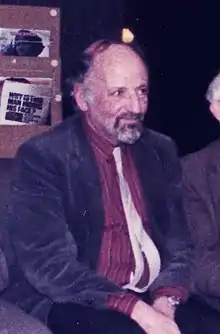Stephen Moorbath
Stephen Erwin Moorbath FRS[4] (9 May 1929–16 October 2016) was a British geochronologist. He set up (1956–58) and then directed the Geological Age and Isotope Research Group at the University of Oxford, before retiring.[2][3][5]
Stephen Moorbath | |
|---|---|
 | |
| Born | 9 May 1929[1] |
| Died | 16 October 2016 (aged 87) |
| Alma mater | Lincoln College, Oxford |
| Awards |
|
| Scientific career | |
| Fields | |
| Institutions | |
Research
Moorbath and his collaborators demonstrated the great gap between Scourian (2,600 million years old) and Laxfordian (1,600 million years old) gneisses in northwest Scotland. He established the basic mineral age pattern of the Scottish and Irish Caledonides (420–450 million years old) and interpreted it as a cooling-uplift interval. He also pioneered lead isotope studies of ancient gneisses, showing that much of the Lewisian existed over 2,900 million years ago. Stephen dated the oldest rocks yet known on the Earth (more than 3,800 million years old) from west Greenland, and applied the rubidium–strontium method to date Torridonian sediments. In addition, he elucidated the complex history of British and Scandinavian lead ores, and showed that the Tertiary acid magmas of Skye are re-melted Lewisian gneisses (more than 3,000 million years old) whereas those of Iceland are of mantle origin.[5]
Awards and honours
Moorbath was elected a Fellow of the Royal Society (FRS) in 1977.[5] In 1978 he was awarded the Murchison Medal by the Geological Society of London and in 1979 he was awarded the Steno Medal by the Danish Geological Society for his work on isotopes and dating the Precambrian of Western Greenland.[6]
References
- "MOORBATH, Prof. Stephen Erwin". Who's Who. ukwhoswho.com. 2016 (online Oxford University Press ed.). A & C Black, an imprint of Bloomsbury Publishing plc. (subscription or UK public library membership required) (subscription required)
- Stephen Moorbath, British Library, retrieved 2016-03-11.
- Whitehouse, M.J; Friend, C. R. L (1998). "Professor Stephen Moorbath, F.R.S. – a retirement tribute". Precambrian Research. 91 (3–4): 229–231. doi:10.1016/S0301-9268(98)00050-3. ISSN 0301-9268.
- Dewey, J. F.; Taylor, P. N. (2020). "Stephen Moorbath. 9 May 1929 — 16 October 2016". Biographical Memoirs of Fellows of the Royal Society. 69.
- "Stephen Moorbath". London: Royal Society. One or more of the preceding sentences may incorporate text from the royalsociety.org website where "all text published under the heading 'Biography' on Fellow profile pages is available under Creative Commons Attribution 4.0 International License.""Royal Society Terms, conditions and policies". Archived from the original on February 20, 2016. Retrieved March 9, 2016.CS1 maint: unfit URL (link)
- Graversen, Ole (1994). "The Steno Medal" (PDF). Bulletin of the Geological Society of Denmark. 41 (2): 117–122.